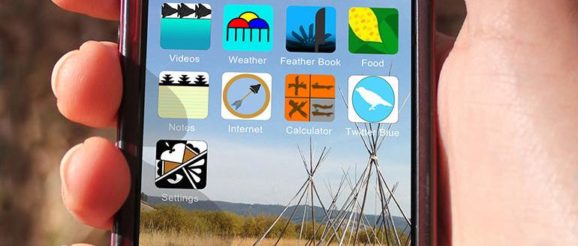“My brain works better at night and that’s what I’m going to be doing.” That was artist Ashley Browning, talking about working on pieces for Santa Fe Indian Market — 10 days before the big event weekend. One of her projects was a special edition of her NDN-opoly piece for IM:EDGE, the market’s new adjunct established to focus on contemporary art.
For NDN-opoly, Browning Native-ized the Monopoly board game. “I actually hand-drew the whole thing and made the cards and money,” she said over coffee. “It was a collaboration with my mom, Michelle Tapia Browning. She does woodworking, so she actually made the little pieces.” Her version of the Monopoly man is holding a sheep and Indian fry bread, and the squares around the outside of the board are named after New Mexico railroads and regionally appropriate tribes and other references: SWAIA, Chile Line, Pine Ridge, Jicarilla Apache, IFAM, and Buffalo Thunder Resort, for example.
“There are only two editions of the game, one at the Museum of Indian Arts and Culture and one is in a private collection.” The piece won a second place award at the 2015 Indian Market, as did Browning’s NDN-iPhone loaded with hand-drawn icons that are Native versions of iPhone apps. There is the Chaco sun dagger (clock), clouds and rain pottery designs (weather), and an arrow (internet), while the wallpaper image is a photograph of a grassland scene with a collection of standing teepee poles. “I worked on a documentary for the U.S. Forest Service in Montana and this image is from Big Hole National Battlefield.”
Photography, graphic design, and digital illustration constitute Browning’s media palette. “I do freehand and I do [Adobe] Illustrator, finding shapes and creating shapes.” Lately, she has been getting into a more figure-based artwork. A new geometric eagle dancer and her 8-bit Deer Dancer show digitally jagged outlines. “My mom thinks it looks like Legos and the kids think of Minecraft.”
Browning’s heritage is both Santa Clara Pueblo and Pojoaque Pueblo. She comes from a long line of Santa Clara potters, as the granddaughter of LuAnn Tafoya and the great-granddaughter of Margaret Tafoya. But she has veered into new territory in her family’s artistic trajectory. “It’s very interesting that I grew up very traditional and I’m progressing into a digital, computerized art form.”
The photographer Phil Karshis was an early influence. “I was about fifteen when I started working at the Poeh Center, and Phil was my boss and he urged me to try it. I would take pictures of people or the artwork that I saw there. A Canon Rebel is my baby, but I’m looking at getting a higher-grade model.” She graduated from the University of New Mexico with a degree in film and digital media. “At some point, I want to go back to school for a master’s program in business or do more graphics, fine arts, or photography. I do want to learn the business side as well as the design side.”
Another work in her portfolio (and a first-place winner at Market) is Generation Hands, a photograph of hands she says represent several generations of strong women; the models are Samantha Whitegeese, Mindy Little Yellow Bird, Tina Whitegeese, Michele Tapia Browning, and Lu Ann Tafoya. Browning created Paper Doll in response to her childhood wish that there could be paper dolls based on Indian people, and especially of the Pueblo of Santa Clara.
Equally personal is Juxtaposition, in which Browning depicts her model, Samantha Whitegeese, divided in two and wearing different types of clothing on each side of her body. “This photo is about a young woman who is balancing her contemporary lifestyle and her traditional pueblo life,” according to her statement about the piece at King Galleries. “It is an everyday challenge that almost every young person deals with while going to school and participating in traditions.”
NDN-opoly and NDN-iPhone are colorful and fun — her creativity seems to include a good dose of play, but she is not oblivious to issues. She is working for the Indian Pueblo Cultural Center in Albuquerque, doing graphic design. She recently did the commemorative poster for the organization’s 5th Annual Pueblo Film Fest: Empowering Women Through Film, scheduled for Nov. 16 through 18. Its red background is symbolic. “When I created this poster, I wanted to focus on Why We Wear RED, the social-media campaign about missing and murdered indigenous women.”
The poster includes a circular pattern of a basket or pottery design over which a hand holds a film reel. A butterfly bracelet on the wrist honors her Indian name, Yellow Butterfly (Puganine Stéjé in Tewa) that was given by her great-grandmother.
“In my past I did a lot of identity work, figuring out what I was and where I am in my community and how that plays into my art. Now I’m just exploring a more technical-based artwork,” said Browning, who was still working on her entry or entries for regular Indian Market, her sixth. ◀

